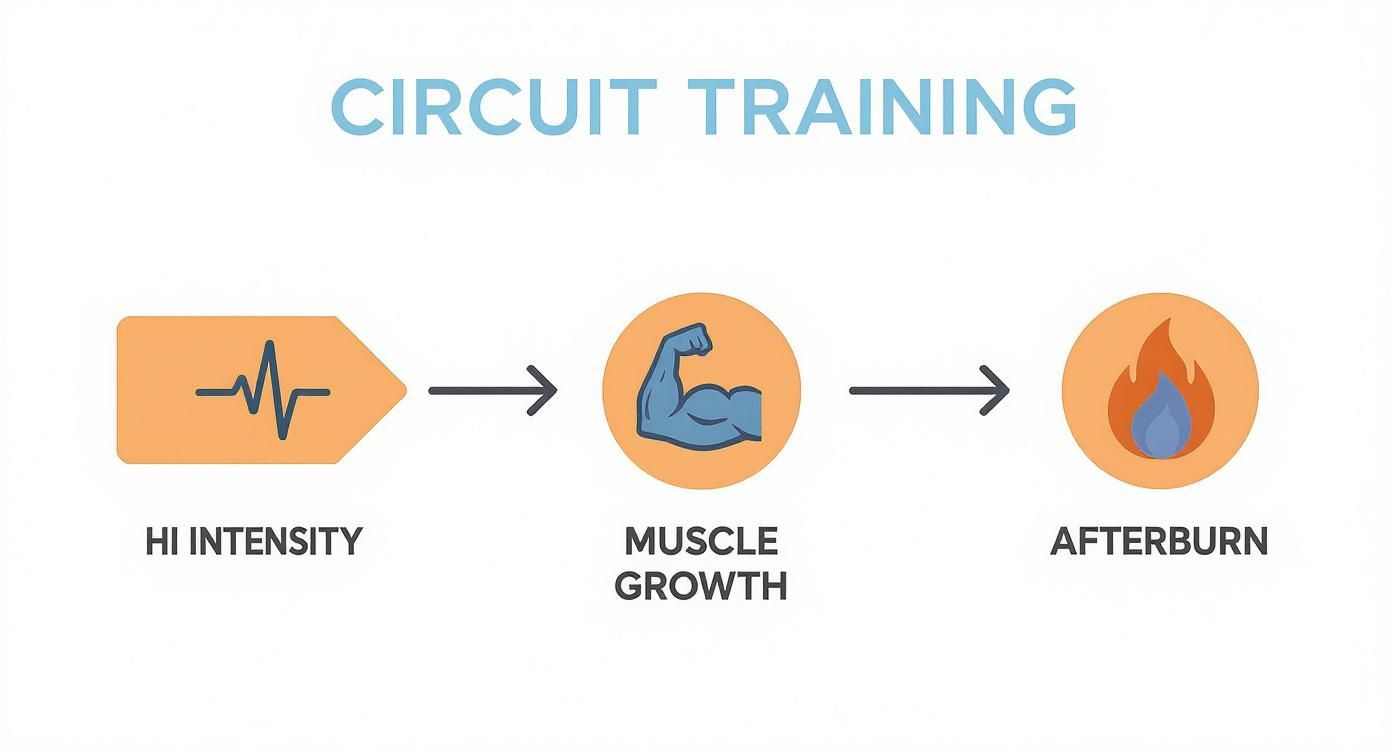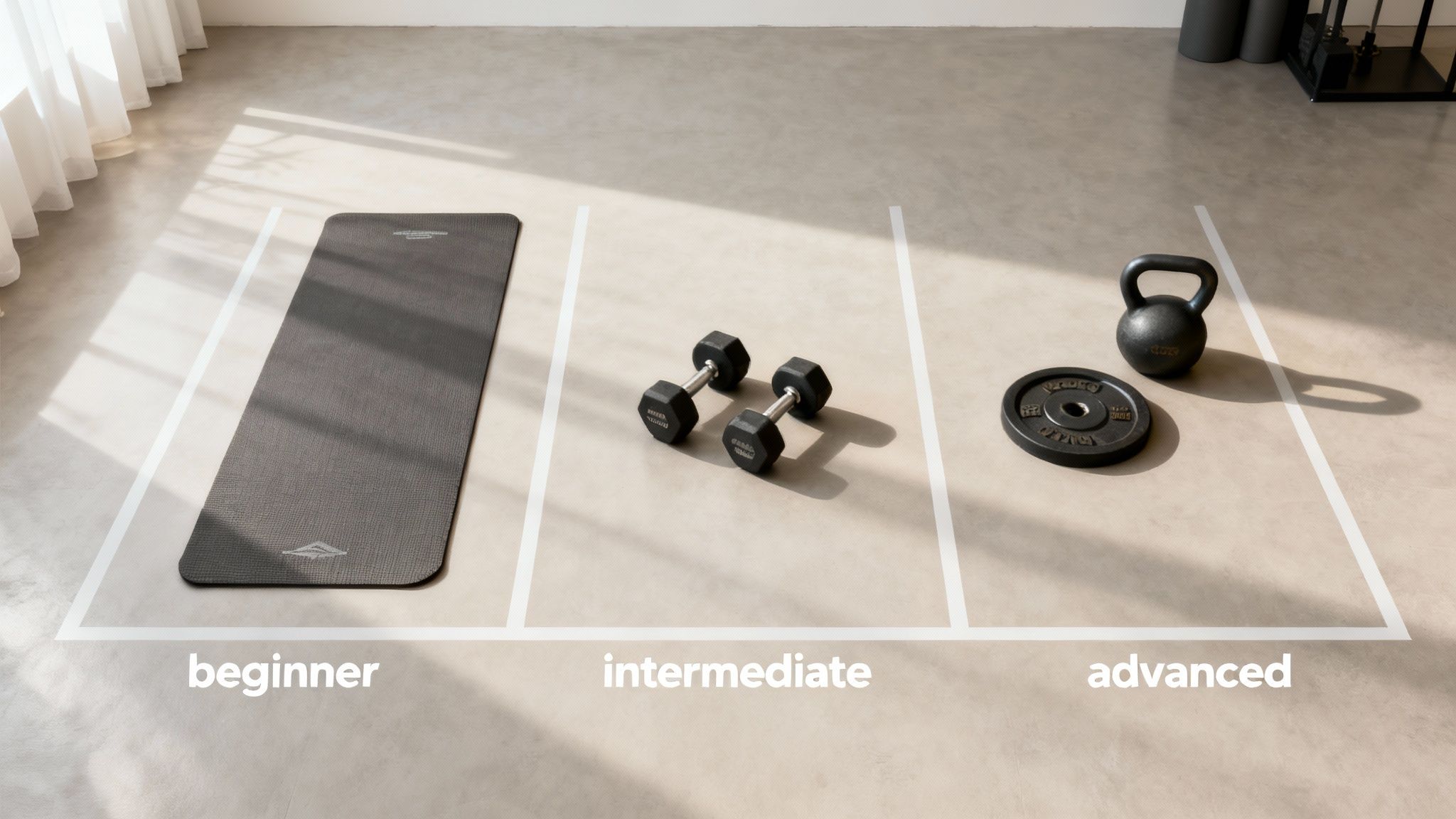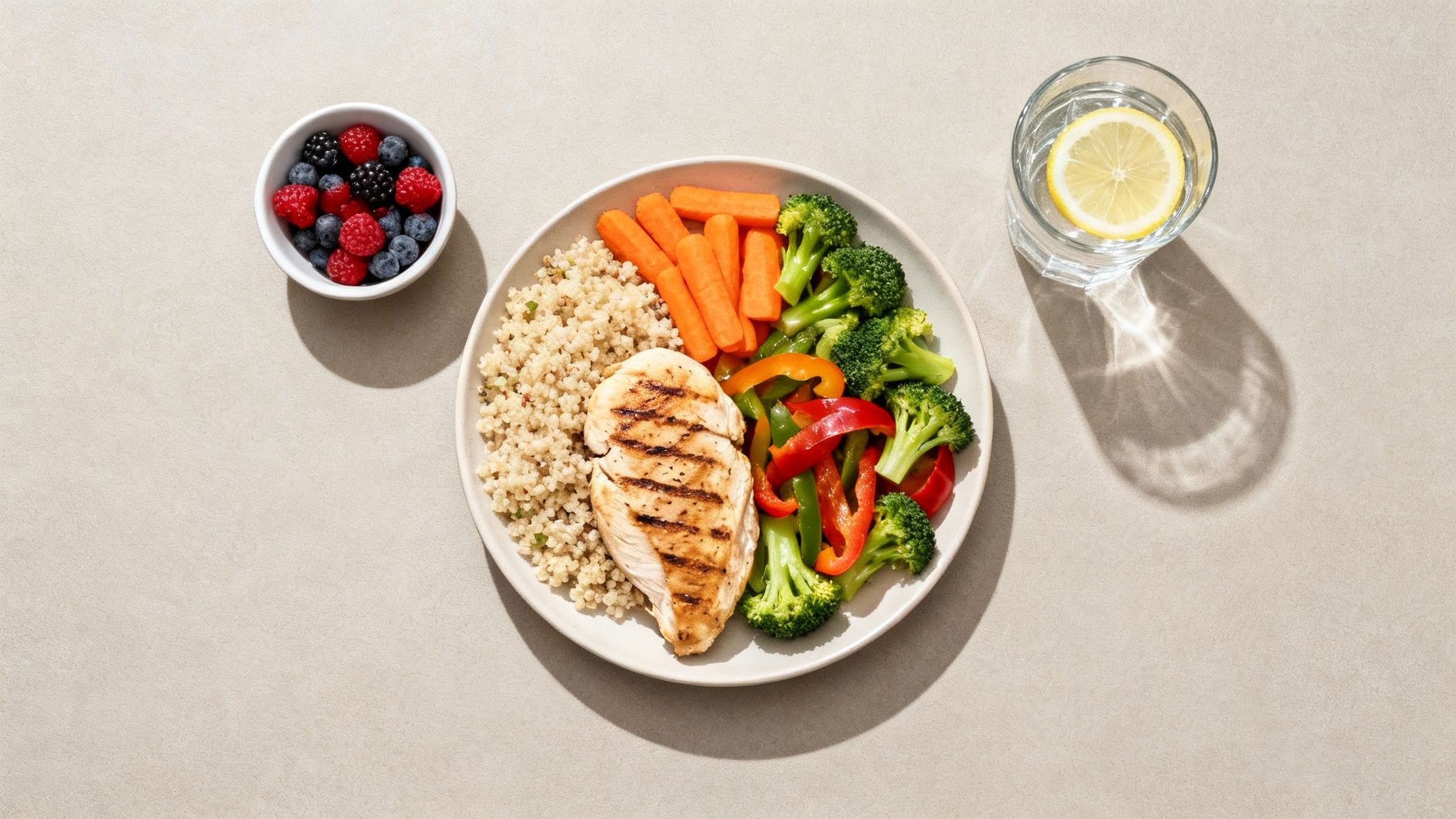Circuit Training for Fat Loss: Your Definitive Guide
- Flourish Everyday Health And Fitness

- 1 day ago
- 10 min read
Circuit training is a powerhouse strategy for fat loss, blending resistance and cardio exercises with minimal rest. This high-intensity style elevates your heart rate and metabolism, torching a significant number of calories both during your workout and for hours afterward.
Index
Why Circuit Training Melts Fat So Effectively
Building Your Ultimate Fat Loss Circuit
Circuits vs Traditional Lifting for Fat Loss
Three Ready-To-Go Fat Loss Circuits
Fueling Your Body for Maximum Fat Burn
Answering Your Top Circuit Training Questions
Top Athletic Shoes for Circuit Training
References
Why Circuit Training Melts Fat So Effectively
The secret to effective fat loss workouts lies in intensity and efficiency. Circuit training masterfully combines both. By moving quickly from one exercise to another, you keep your heart rate elevated, turning your entire session into a highly effective cardio workout, even while lifting weights. This mix of strength and cardio demands more oxygen and energy from your whole body, leading to a massive calorie burn in a short time.
The Science of the Afterburn Effect
One of the most significant benefits of circuit training is the “afterburn effect,” or Excess Post-exercise Oxygen Consumption (EPOC). After an intense circuit, your body works hard to recover—replenishing oxygen stores, clearing metabolic waste, and repairing muscle. This recovery process burns additional calories, keeping your metabolism elevated for hours after you've left the gym. The more intense the circuit, the greater the afterburn. This provides a distinct advantage over steady-state cardio, where the calorie burn stops when the activity does. For a deeper look into high-intensity training, you might be interested in our guide on why HIIT workouts are the best for overall fitness.
Key Takeaway: Circuit training leverages the afterburn effect, meaning your metabolism stays elevated for hours post-workout. This extended calorie burn is a critical component for accelerating fat loss.
Key Benefits of Circuit Training for Fat Loss
Here’s a summary of why circuit training is a game-changer for shedding fat.
Benefit | How It Accelerates Fat Loss |
|---|---|
Metabolic Boost | High intensity keeps your metabolism elevated for hours post-workout (EPOC). |
Time Efficiency | Combines cardio and strength training into one short, powerful session. |
Muscle Building | Resistance exercises build lean muscle, which increases your resting metabolic rate. |
Enhanced Calorie Burn | The mix of exercises burns more calories per minute than traditional workouts. |
Building Muscle to Boost Metabolism
Circuit training changes your body’s composition to burn more fat 24/7. By incorporating resistance exercises like squats, presses, and rows, you stimulate muscle growth. Muscle is metabolically active, meaning it burns more calories at rest than fat tissue. Building more lean muscle increases your resting metabolic rate (RMR), so you burn more calories all day long.
A systematic review confirmed that resistance circuit-based training led to a significant 4.3% reduction in fat mass while increasing muscle mass by an average of 1.9% (Paoli et al., 2017). This dual effect—burning fat while building muscle—makes circuit training a powerful strategy for getting and staying lean.
Building Your Ultimate Fat Loss Circuit
An effective fat-burning circuit is about strategic design. The goal is to create a workout that keeps your heart rate high, hits multiple muscle groups, and boosts your metabolism without causing premature burnout. A well-designed circuit blends different movements—compound lifts, targeted work, and cardio—to keep intensity high from start to finish.
Selecting Your Exercises Strategically
The foundation of a great circuit is a balanced mix of exercises. A sweet spot is typically 6-10 different movements, or "stations."
Compound Lifts: These are your most metabolically demanding exercises, working multiple joints and large muscle groups at once (e.g., Goblet Squats, Dumbbell Bench Presses, Kettlebell Swings).
Targeted Moves: Single-joint exercises like Bicep Curls or Tricep Extensions can add volume and push muscles further.
Cardio Bursts: Essential for keeping your heart rate soaring. Include exercises like High Knees, Burpees, or Jumping Jacks between strength moves.
This infographic breaks down exactly how circuit training torches fat and builds muscle at the same time.

As you can see, the high intensity triggers muscle growth, which then fuels that awesome afterburn effect for more sustained fat loss long after you've left the gym.
Structuring Work and Rest Intervals
Your work-to-rest ratio dictates the intensity of the workout and should match your fitness level. A good starting point is 45 seconds of work followed by 15 seconds of rest. As you improve, you can adjust the intervals.
A study on elite rowers found their energy expenditure could reach nearly 50 kcal per minute during an all-out effort (Hagerman & Staron, 1983). While most of us are not Olympians, this demonstrates that intense work followed by brief recovery drives a massive calorie burn.
Here are common work-to-rest protocols:
Beginner (1:1 Ratio): 30 seconds work, 30 seconds rest.
Intermediate (2:1 Ratio): 40 seconds work, 20 seconds rest.
Advanced (3:1 Ratio): 45 seconds work, 15 seconds rest.
Creating a Seamless Workout Flow
Arrange exercises intelligently to avoid premature fatigue. The key rule is to avoid working the same muscle group back-to-back. This allows one part of your body to recover while another works, helping you maintain a higher output. Alternate between upper-body, lower-body, and full-body cardio movements.
Example of an effective circuit flow:
Station 1 (Lower Body): Goblet Squats
Station 2 (Upper Push): Incline Dumbbell Press
Station 3 (Cardio): Burpees
Station 4 (Lower Body/Posterior): Kettlebell Swings
Station 5 (Upper Pull): Dumbbell Rows
Station 6 (Core): Plank
This sequence ensures a powerful and productive circuit training for fat loss session.
Circuits vs Traditional Lifting for Fat Loss
When fat loss is the goal, should you choose fast-paced circuits or heavy, traditional lifting? The best answer depends on your schedule, goals, and personal preferences.
Traditional strength training involves lifting heavy for a set number of reps, followed by long rest periods (2 to 3 minutes). This method is unparalleled for building maximal strength and muscle size. Circuit training uses moderate weights with minimal rest, creating a metabolic furnace that combines cardiovascular conditioning and muscle stimulation.
Time Efficiency and Metabolic Impact
High-Intensity Circuit Training (HICT) is incredibly efficient. You can complete a full-body workout in 30 minutes that might take over an hour with a traditional routine. This non-stop movement torches a high number of calories during the workout and significantly boosts the afterburn effect (EPOC). While traditional lifting also provides an EPOC boost, circuits tend to create a larger immediate metabolic impact.
A study comparing HICT with traditional strength training found both methods similarly effective for enhancing strength and lean body mass while reducing body fat percentage. HICT delivered comparable results in much less time (Alcaraz et al., 2011).
HICT vs Traditional Strength Training: A Comparison
Feature | High-Intensity Circuit Training (HICT) | Traditional Strength Training |
|---|---|---|
Primary Goal | Fat loss, muscular endurance, cardio | Maximal strength, muscle hypertrophy |
Workout Duration | 20-30 minutes | 45-90 minutes |
Rest Periods | 15-30 seconds (or none) | 2-5 minutes |
Intensity | High heart rate, moderate weight | High weight, low reps |
Calorie Burn (During) | Very high | Moderate |
EPOC (Afterburn) | Significant | Moderate to significant |
Best For | Time-crunched individuals, fat loss | Building maximum strength & size |
Muscle Growth Potential
Traditional lifting excels at creating mechanical tension, the primary driver of muscle growth (hypertrophy). If your main goal is getting as big and strong as possible, heavy lifting is superior. However, circuits are fantastic at creating metabolic stress, another key factor for muscle growth. The high-volume, short-rest work can trigger hypertrophy, especially for those not aiming to be competitive bodybuilders. To learn more, see our guide on the top resistance training exercises to unleash your strength.
The smartest approach is often a blend of both. You might dedicate two days a week to heavy lifting for strength and another two to circuits for conditioning and fat loss, giving you the best of both worlds.
Three Ready-To-Go Fat Loss Circuits

Here are three complete circuits for different fitness levels. These templates provide a clear roadmap for circuit training for fat loss.
The Foundational Bodyweight Circuit
This beginner-friendly circuit uses only your bodyweight, perfect for mastering basic movements.
The Structure:
Work Interval: 40 seconds per exercise
Rest Interval: 20 seconds between exercises
Total Rounds: Complete 3 rounds
Rest Between Rounds: 60-90 seconds
The Exercises:
Bodyweight Squats: Push hips back and down, keeping your chest up.
Incline Push-ups: Use a bench or chair to reduce the load while building strength.
Alternating Lunges: Step forward, lowering your back knee toward the floor.
Plank: Maintain a straight line from head to heels.
Jumping Jacks: A cardio burst to keep your heart rate up.
The Intermediate Dumbbell Challenge
This circuit adds dumbbells to increase resistance, build more lean muscle, and boost your metabolism.
The Structure:
Work Interval: 45 seconds per exercise
Rest Interval: 15 seconds between exercises
Total Rounds: Complete 4 rounds
Rest Between Rounds: 60 seconds
The Exercises:
Dumbbell Goblet Squats: Hold one dumbbell vertically against your chest.
Dumbbell Renegade Rows: In a push-up position, row one dumbbell to your chest, then the other, keeping hips stable.
Dumbbell Reverse Lunges: Holding dumbbells, step backward into a lunge.
Dumbbell Floor Press: Lie on your back and press dumbbells up from your chest.
Burpees (No Push-up): A high-intensity finisher for your cardiovascular system.
The Advanced Metabolic Push
For experienced individuals, this circuit combines heavier weights and plyometrics with minimal rest to maximize the afterburn effect.
The Structure:
Work Interval: 50 seconds per exercise
Rest Interval: 10 seconds between exercises
Total Rounds: Complete 4-5 rounds
Rest Between Rounds: 45-60 seconds
The Exercises:
Kettlebell Swings: An explosive hip-hinge movement that torches calories.
Dumbbell Thrusters: A seamless front squat into an overhead press.
Pull-ups (or Bodyweight Rows): The ultimate upper-body pulling exercise.
Box Jumps: An explosive plyometric move to build power and elevate heart rate.
Farmer's Carry: Pick up heavy weights and walk to build grip strength and core stability.
Fueling Your Body for Maximum Fat Burn

Your effort in the gym is only half the battle. You cannot out-train a poor diet. Smart, sustainable eating habits are essential to fuel your workouts, promote recovery, and achieve the results you want.
The Smart Calorie Deficit
To lose fat, you must be in a calorie deficit, meaning you burn more calories than you consume. A moderate deficit of 300-500 calories per day is ideal. This promotes steady, sustainable fat loss without causing muscle loss, energy crashes, or a stalled metabolism.
Prioritize Protein to Protect Muscle
In a calorie deficit, your body may break down muscle for energy. To prevent this, make protein your priority. Aim for 0.7-1.0 grams of protein per pound of body weight. Protein helps preserve lean muscle and keeps you feeling fuller for longer, making it easier to stick to your calorie goals. Good sources include lean meats, fish, eggs, Greek yogurt, legumes, and quality protein powders.
In one study, a 12-week circuit training program combining resistance and aerobic exercises led to significant reductions in body weight, body fat percentage, and BMI, highlighting the synergy between smart training and supportive nutrition (Gettman et al., 1982).
Time Your Carbs for Energy and Recovery
Carbohydrates are your body's preferred fuel source for high-intensity workouts.
Pre-Workout: A serving of complex carbs (like oatmeal) 1-2 hours before your session tops off energy stores.
Post-Workout: Consuming carbs with protein within an hour or two after your circuit helps replenish energy and start muscle repair.
For more on this topic, see our guide to pre and post workout nutrition for maximum results. Also, stay hydrated. Proper hydration is crucial for performance, metabolism, and recovery.
Answering Your Top Circuit Training Questions
Here are answers to common questions about using circuit training for fat loss.
How Often Should I Do Circuit Training?
Aim for 2 to 4 sessions per week. This frequency provides enough stimulus for fat loss and muscle toning while allowing adequate time for recovery. Overtraining is a risk with high-intensity work, so listen to your body and take rest days when needed.
Can I Build Muscle with Just Circuits?
Yes, especially if you are new to lifting. Circuits create metabolic stress, a key driver of muscle growth. However, for maximizing muscle size (hypertrophy), traditional strength training with heavier weights and longer rest is more effective at creating the necessary "mechanical tension." A hybrid approach, combining circuits for conditioning and heavy lifting for strength, is often ideal.
How Long Should a Circuit Workout Last?
A solid fat loss circuit should last 20 to 45 minutes, including a warm-up and cool-down. This is long enough to boost your metabolism and trigger the afterburn effect without leading to burnout or poor form.
Should I Do Cardio on Separate Days?
For most people, the cardio is already integrated into the circuit. However, adding low-intensity, steady-state (LISS) cardio like brisk walking or cycling on off days can aid recovery by increasing blood flow, add to your weekly calorie burn, and improve your aerobic base. Keep any extra cardio light and treat it as active recovery.
Top Athletic Shoes for Circuit Training
Having the right footwear is crucial for safety and performance during circuit training. The ideal shoe offers a combination of stability for lifting, flexibility for dynamic movements, and cushioning for impact.
For Women
Nike Metcon 9: A top choice for its stability, featuring a wide, flat heel perfect for squats and deadlifts. The flexible forefoot allows for agility during jumps and lunges.
Reebok Nano X4: Known for its versatility and comfort. It provides a stable base for lifting while offering enough cushioning and flexibility for sprints and box jumps.
Under Armour TriBase Reign 6: This shoe excels in ground contact and stability. The low-to-the-ground design gives you excellent feedback and power transfer during heavy lifts.
For Men
Nike Metcon 9: Just as popular for men, it delivers the stability and durability needed for intense, varied workouts. The Hyperlift insert in the heel provides extra support for heavy lifts.
Reebok Nano X4: A workhorse shoe that balances stability with responsive cushioning. It’s durable enough for rope climbs and flexible enough for burpees.
Adidas Dropset 2: Specifically designed for strength training, it features a dual-density midsole that is firm in the heel for stability and softer in the forefoot for comfort during dynamic movements.
References
Alcaraz, P. E., Sanchez-Lorente, J., & Blazevich, A. J. (2011). Physical performance and cardiovascular responses to an acute bout of heavy resistance circuit training versus traditional strength training. Journal of Strength and Conditioning Research, 25(5), 1277-1283.
Gettman, L. R., Ward, P., & Hagan, R. D. (1982). A comparison of combined running and weight training with circuit weight training. Medicine and Science in Sports and Exercise, 14(3), 229-234.
Hagerman, F. C., & Staron, R. S. (1983). Seasonal variations in selected blood parameters of elite rowers. The Physician and Sportsmedicine, 11(1), 91-99.
Paoli, A., Gentil, P., Moro, T., Marcolin, G., & Bianco, A. (2017). Resistance training with single vs. multi-joint exercises at equal total load volume: effects on body composition, cardiorespiratory fitness, and muscle strength. Frontiers in Physiology, 8, 1105.
At Flourish-Everyday, we believe that the right information and the right gear are essential for your fitness journey. We provide expert reviews on the best athletic shoes and reliable health insights to support your goals. Find everything you need to build a stronger, healthier lifestyle at https://www.flourish-everyday.com.
Comments